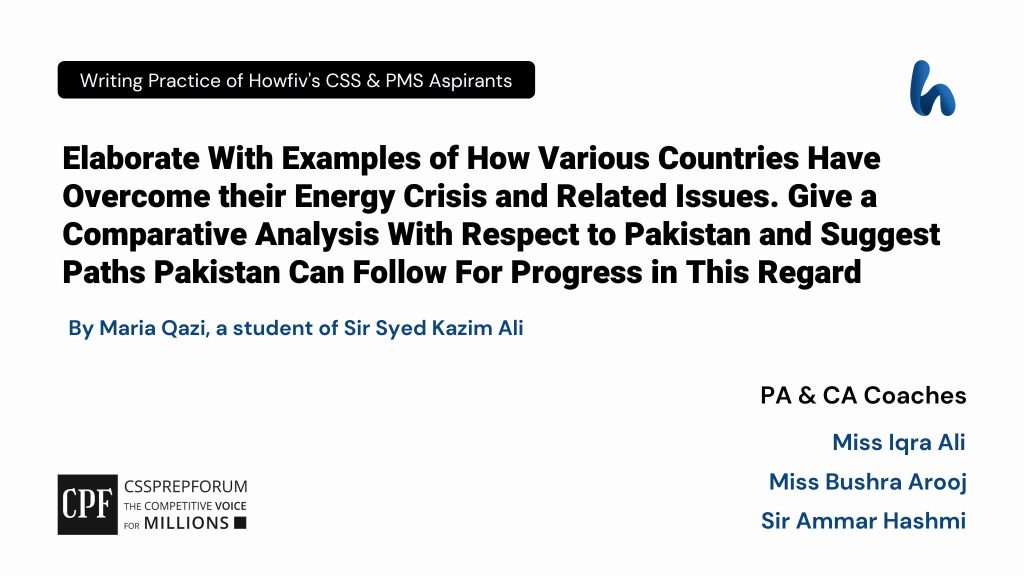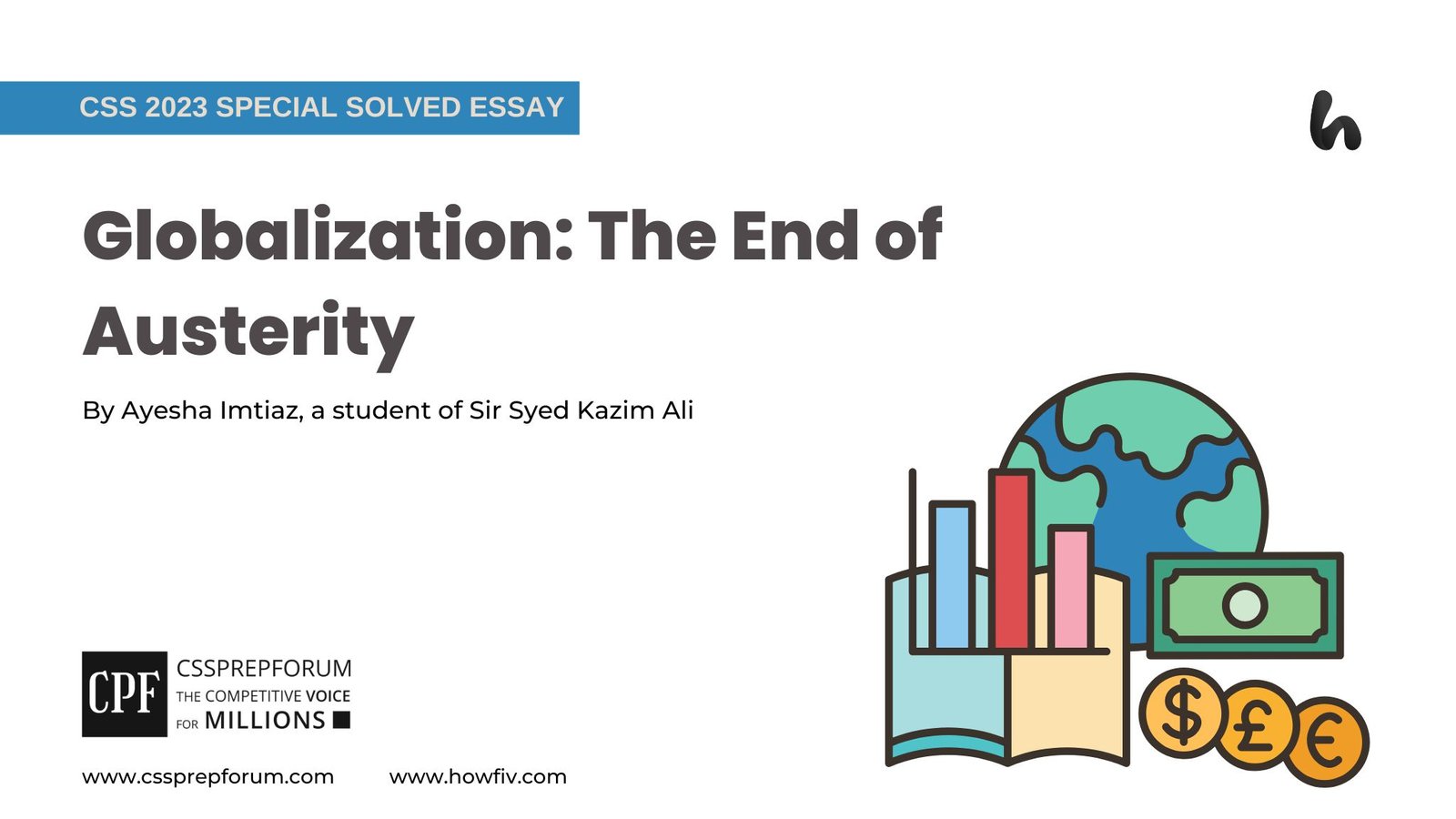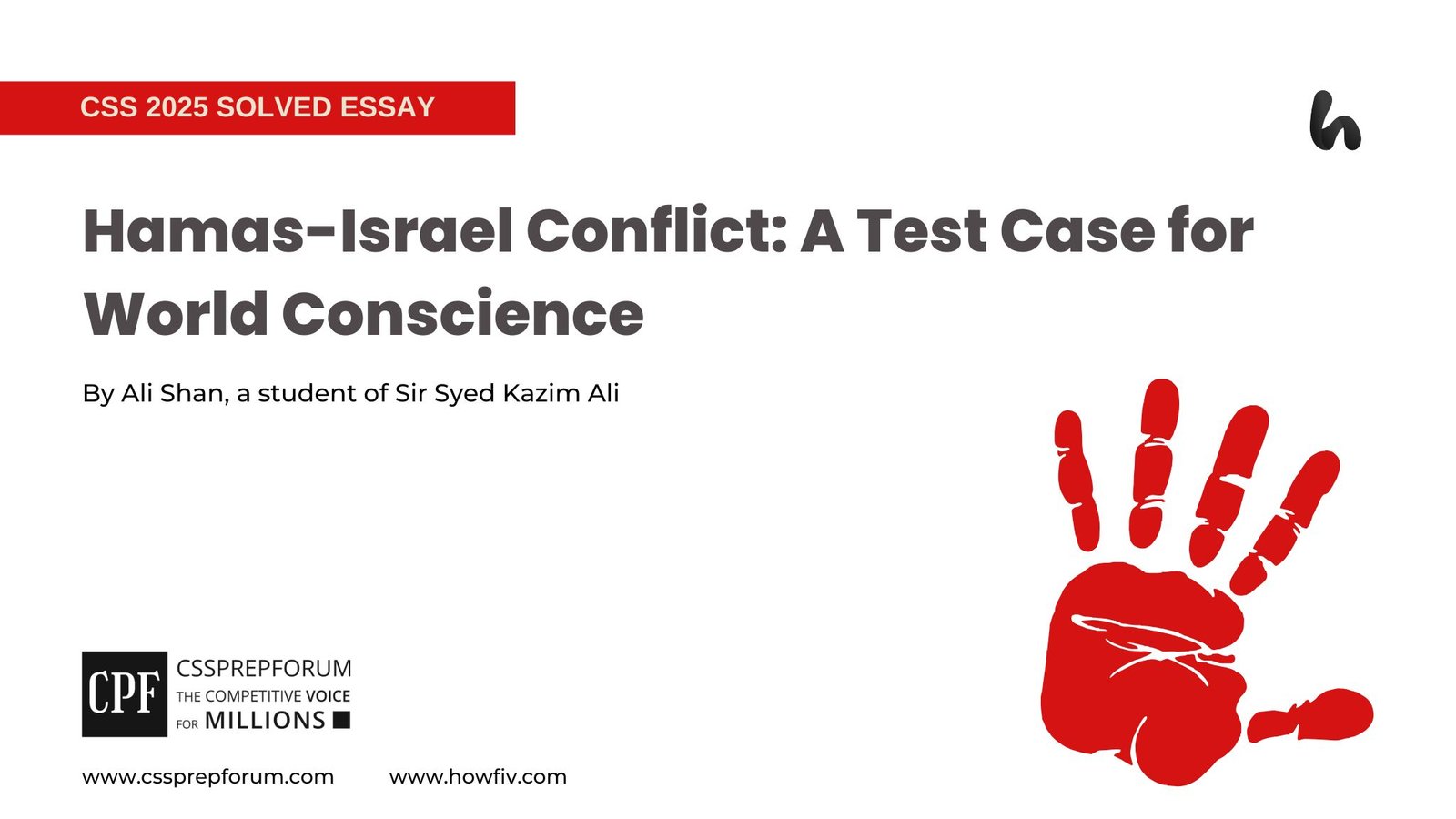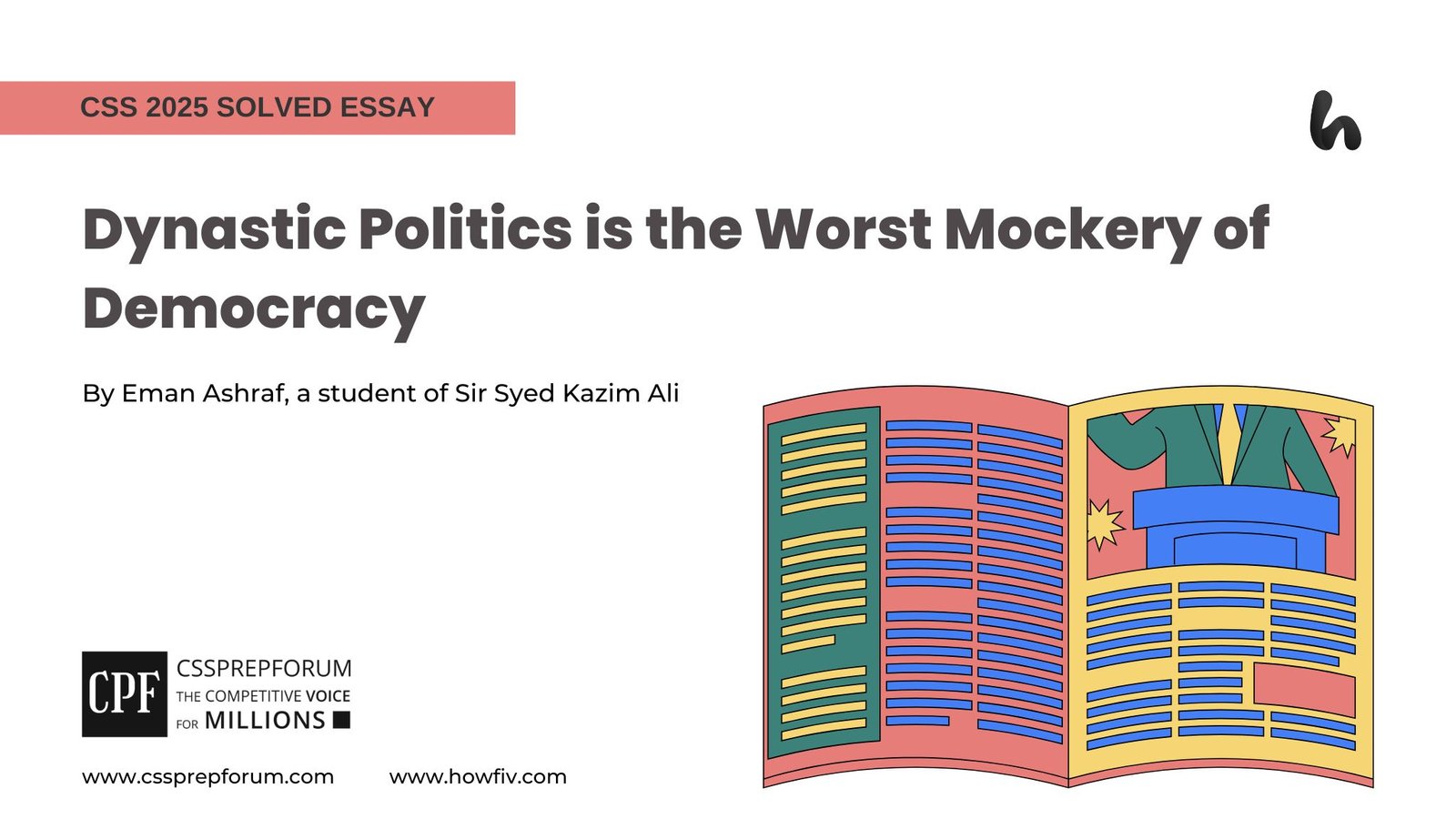CSS Current Affairs | Lessons for Pakistan to Overcome Energy Crisis
The following question of CSS Current Affairs is solved by Maria Qazi under the supervision of Howfiv’s Pakistan Affairs and Current Affairs Coaches. She learnt how to attempt 20 marks question and essay writing from Sir Syed Kazim Ali, Pakistan’s best CSS and PMS English essay and precis teacher with the highest success rate of his students. This solved past paper question is attempted on the pattern taught by Sir to his students, scoring the highest marks in compulsory and optional subjects for years, and uploaded to help aspirants understand how to crack a topic or question, how to write relevantly, what coherence is, and how to include and connect ideas, opinions, and suggestions to score the maximum.

Outline
1- Introduction
2- Importance of energy for a country
3- Examples of various countries successfully coming out of the energy crisis
- Case study: Norway
- Evidence: According to the International Energy Agency, Norway has a renewable-based electricity system that accounts for 98 per cent of the generation, of which hydro is the 92% source.
- Case study: New Zeeland
- Evidence: According to the Energy Efficiency and Conservation Authority (EECA), Norway generates 80 to 85 % of its electricity from renewable resources.
- Case study: France
- Evidence: According to the International Trade Administration, France plans to reduce nuclear in the energy mix for electricity production from over 70 % to 50% by 2035.
- Case Study: Switzerland
- Evidence: According to the International Energy Agency, 63 per cent of Swiss electricity is generated from renewable resources, mainly 57 per cent of hydropower.
- Case study: Denmark
- Evidence: As stated by Denmark’s Government, 53.6 per cent of the country’s energy is generated by wind power, and it hopes to proceed to 60 per cent by 2030 and 100 per cent by 2050.
4- Energy situation of Pakistan: a comparative analysis
5- Pragmatic Measures to overcome energy crisis in Pakistan
- 5.1 Long-term Solution
- Making Strong Efforts in Adopting Alternative and Renewable Energy (ARE) Policy
- Upgradation of Distribution Mechanism
- 5.2 Medium-Term Solutions
- Reviving Forgotten Projects
- Advancing Hydel Projects
- 5.3 Short-Run Solutions
- Reducing Circular Debt
- Following the Right Resource Management Strategies
6- Conclusion

Answer to the Question
Introduction
Energy, the greatest demand of the world, is indispensable for a country’s economic, social, and political well-being, allowing the nation to make its say in the comity of countries. However, a nation without sustainable energy and effective and sufficient energy policies always bow in front of foreign countries for its social, economic, and political development. Unfortunately, despite being an energy-rich country, Pakistan is grappling with the energy crisis. The nation’s 60 per cent energy is skewed toward non-renewable resources, such as oil and gas, making it vulnerable to complying with the growing demands of energy. According to the NEPRA, the country’s power sector is “already replete with multiple issues including the huge capacity payment obligation, inefficiencies in the generation, transmission and distribution segments, whopping circular debt etc, faced unprecedented high cost for electric power services”. Furthermore, the regretful energy system has resulted in hiking bills, price fluctuation, supply disruptions, frequent blackouts, circular debt, and power thefts. To curb the menace, it is high time for the nation to transmit its energy production from non-renewable resources to renewable resources, which is the way energy-prosperous countries like France, Switzerland, and Denmark have shifted. For this purpose, there is a dire need for immediate initiatives like implementing the Alternative and Renewable Energy (ARE) policy, upgrading distribution mechanisms, reviving forgotten projects, and advancing hydel projects. To conclude, the article sheds light on Pakistan’s energy situation and suggests short- and long-term pragmatic measures to overcome the catastrophe.
Importance of energy
Energy is the gateway to a nation’s social, economic, and political prosperity. It undoubtedly empowers the industrial and agricultural sectors and enhances transportation, modern medical equipment, trade, and communication, as it is the building block for these services. Moreover, countries having sustainable energy always attract the world toward themselves for diplomatic ties, trade, and economic affairs as energy is in the highest demand in the world for increasing development in all aspects of life. These countries actually, through sustainable energy, maintain their policies and hegemony and rule the world of economy. However, without sufficient energy policies, a nation faces dependency on developed countries for its social, economic, and political prosperity. A nation cannot control its energy sources and cannot control its future, as stated by former U.S. President Barack Obama. Thus, perseverance and effective and sufficient use of energy not only cushion a country from reliance on energy-sufficient countries but also develop and sustain its economy.
Examples of countries successfully coming out of the energy crisis.
Various developing countries have boosted their economy and maintained their political and social might by implementing effective and efficient energy policies, ensuring reliance on renewable energy instead of consuming non-renewable energy resources. Countries including Norway, France, New Zealand, Switzerland, and Denmark are glaring examples of nations who, while making proper initiatives and developing their energy sectors, especially on net zero emissions, have sustained energy security.
- Case Study of Norway
To begin with, Norway although being the seventh-largest oil and gas exporter and providing 3 percent of the global gas consumption, the nation’s concentration on sustaining its energy by developing renewable resources has made it achieve highest performer in the energy sector. Currently, Norway has 100 per cent of its power production from renewable sources, stemming 95 per cent from 1600 hydropower plant and 3.5 per cent from wind power.
- Case Study of New Zeeland
Likewise, through effective and efficient energy policies, New Zealand has not only leveraged its energy sectors but also achieved a sustainable economy, fostering its self-sufficiency. 80-85 per cent of the nation’s electricity is generated from renewable energy resources, mitigating its reliance on fossil fuels. According to the Energy Efficiency and Conservation Authority (EECA), Norway generates 80 to 85 % of its electricity from renewable resources. Moreover, the government’s vision to highly achieve a renewable, sustainable, and efficient energy system by 2050 has ensured its future well-being.
- Case Study of France
Importantly, after confronting energy insecurity due to the Russian-Ukraine war due to its reliance on Russian energy imports, France has adopted a new energy policy, aiming to reduce the contribution of nuclear power generation to 50 per cent, dive deep for sustainable renewable energy resources, and deter fossil fuels consumption. According to the International Trade Administration, France plans to reduce nuclear in the energy mix for electricity production from over 70 % to 50% by 2035. Moreover, France’s initiatives for energy security have not only assisted the nation in becoming self-sufficient but also attained sustainable energy production and fostered its industrial competitiveness.
- Case Study of Switzerland
Moreover, ranking second after France, Switzerland has performed well in energy domains with the aim of generating 35 TWH of power from renewable resources by 2035 and 45 TWH by 2050, making it less dependent on energy imports. Currently, 63 per cent of Swiss electricity is generated from renewable resources, mainly 57 per cent from hydropower, as stated by the International Energy Agency.
- Case Study of Denmark
Last, in the case of Denmark, for fifty years, Denmark has been making efforts to transmit its energy from non-renewable resources to renewable resources. In pursuit of its goal, the nation has manufactured thousands of wind tribunes, generating 6.9 GW of electricity on land and 4 593 at sea, which made the nation adopt self-sustainable energy. 53.6 per cent of the country’s energy is generated by wind power, and it hopes to proceed to 60 per cent by 2030 and 100 per cent by 2050, as stated by Denmark’s Government. Moreover, owing to its wind tribunes, the nation has the capability to build artificial islands with accumulated power.
Energy situation of Pakistan: a comparative analysis
Comparatively, in comparison with India, which is building a power plant equal to Singapore and Denmark, having the potential to build the first artificial island from renewable energy collected from wind power, Pakistan’s dream of making its energy sector self-sufficient is far-reaching. Currently, Pakistan is an energy-deficient country that has failed to shift to renewable resources for its energy requirements due to insufficient and ineffective energy policies. Most of its energy is derived from non-renewable resources, such as fossil fuels. As reported by the National Electric Power Regulatory Authority (NEPRA), the nation’s 59% energy is derived from renewable resources, 7% from renewable resources, including wind, solar, and biomass, 25% from hydro, and 9% from nuclear, generating 43,775 MW in total. Additionally, despite being an energy-rich country, Pakistan is based on foreign resources _United Arab Emirates, Russia, Saudi Arab_ and international agreements such as CPEC, CASA/1000, and IPP for its energy requirements as the nation’s energy sector lacks pragmatic energy policies and importantly the political will to become energy self-sufficient. Moreover, the surging energy circular debt, PRs 5.725 trillion, has further shaken the energy sector. Thus, despite having energy-rich resources, Pakistan’s energy sector is in a declining trend due to the inefficiency and ineffectiveness of its policies.
Pragmatic Measures to overcome energy crisis in Pakistan
Pakistan should identify a recovery method that leverages the accessibility, viability, and reliability of renewable energy while maintaining the growing levels of energy consumption it has witnessed in the last decade.
Long Term Solutions
- Making Strong Efforts in Adopting Alternative and Renewable Energy (ARE) Policy
To save Pakistan’s energy sector from drowning, formulation and implementation of the Alternative and Renewable Energy (ARE) policy should be given serious and prior attention as it is the stepping stone for the protection of non-renewable resources by shifting energy supplies from non-renewable to non-renewable resources. Under ARE policy, energy resources, including solar, wind, hydroelectric, and biomass, offer ways out of the current energy plight. Embracing the ARE policy not only provides Pakistan with an opportunity to overcome energy deficiency but also paves the path for sustainable economic growth and sustainable, affordable, efficient, environment-friendly, and prosperous energy by 2030. Hence, the government’s strong efforts toward implementing the ARE policy are required to save the energy sector’s drowning boat.
- Upgradation of Distribution Mechanism
Unfortunately, Pakistan’s power distribution industry has been experiencing financial, technical, non-technical, and disruption issues that result in frequent power cuts, blackouts, high tariffs, line losses, power theft, poor services, and economic losses. The process of distribution from transmission to consumers has been in a declining trend since 2007. To overcome the issue, policymakers should aim to make long-term and short-term solutions by improving financial viability, introducing advanced metering infrastructure, reducing distribution losses, improving revenue collection, modernizing the electricity and billing system, and creating a transparent customer service system. To ensure this, accountability and transparency of NEPRA and DISCO should be standardized. Thus, there is a dire need for permanent change in the overall distribution system.
Medium Term Solution
- Reviving forgotten projects
Next, Abandoned projects, including the IP gas pipeline project, CASA/1000, and the TAPI gas pipeline, would not be disregarded anymore as the projects can be the stepping stone to prosperous and sustainable energy. Pakistan has the potential to import 4,000 megawatts of electricity from IP, 1,700 to 4,000 megawatts of electricity from TAPI, and 1,300 MW of electricity from CASA/1000, facilitating the nation’s energy sector to meet the growing demands for power. Furthermore, the completion of the projects helps the nation foster its economy, which leads to reducing tariffs, bills, and fund demands.
- Advancing hydel projects
Additionally, being a water-rich country, Pakistan, unfortunately, has failed to achieve progress in hydel power generation. The hydel projects of Pakistan have the potential to meet the overall challenges of the energy sector and make the nation self-sufficient in sustaining energy. The projects: Suki Kanari on River Kunhar produces 874MW, Karot on River Jhelum produces 720MW, Diamir Basha on River Indus produces 4500MW, and Kala Bagh on River Indus produces 3600MW, would lead to energy sustainability if generated successfully. Thus, the nation should invest and support the completion of projects to foster energy viability.
Short-Run solution
- Reducing circular debt
Apart from that, to overcome the recent energy crisis and hiking bills, the nation’s energy sector needs to reduce its circular debt by following some pragmatic measures. To begin with, the state should privatize or break down large discos into smaller units and make them perform independently. Further, the sector should revise IPP’s contracts, rationalize power subsidies, prevent power theft via technological interventions, and, above all, identify and penalize corrupt workers on a large scale. Thus, the solutions can mitigate the looming energy crisis and also make a way out for efficient and viable investments.
- Following the Right Resource Management Strategies
Last but not least, effective resource management in the energy sector is highly important to mitigate the current rising electricity costs and energy unavailability. For this purpose, pragmatic measures such as efficient utilization of available resources, minimizing workforce workloads, incrementing administration productivity, optimizing project cost, and improving project outcomes would definitely lighten the energy sector from unnecessary burdens and bring relief to the situation.
Conclusion
To conclude, Pakistan’s energy sector has been going under challenging circumstances owing to its ineffective and insufficient energy policies. To illustrate, the nation’s more than 60 per cent of its energy is supplied from non-renewable resources, gas and oil, making it an energy-deficient country that has failed to meet the growing demands of its population, industries, and agricultural sector. As a result, the country is grappling with hiking bills, shortfalls, electricity outages, the shutdown of industries, power thefts, and, above all, economic instability. To meet the challenges, it is crucial for the nation to adopt effective and sufficient policies such as shifting its energy use from non-renewable resources to renewable resources, advancing its solar and hydel projects, and bringing structural reforms to its energy sector.

CSS Solved Past Papers’ Essays
Looking for the last ten years of CSS and PMS Solved Essays and want to know how Sir Kazim’s students write and score the highest marks in the essays’ papers? Then, click on the CSS Solved Essays to start reading them.
CSS Solved Essays
CSS Solved General Science & Ability Past Papers
Want to read the last ten years’ General Science & Ability Solved Past Papers to learn how to attempt them and to score high? Let’s click on the link below to read them all freely. All past papers have been solved by Pakistan’s top CSS GSA coach having the highest score of their students.
General Science & Ability











